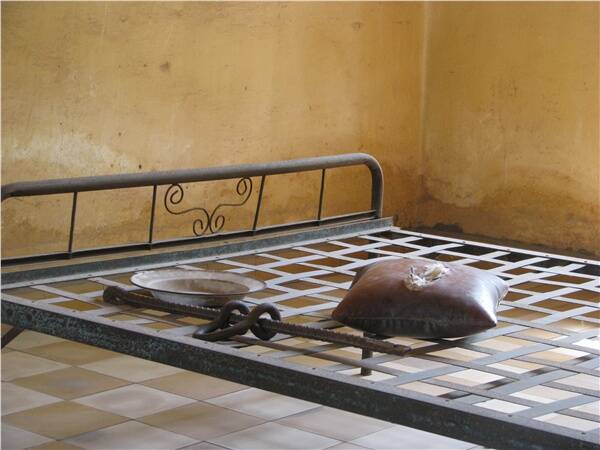



The former S21 prison in Cambodia's capital, Phnom Penh, where an estimated 20,000 victims were tortured before being killed, is one of the most confronting places I have ever experienced. I don't know anywhere else in the world where the tools used to torture the victims and the steel beds to which they were chained remain on display exactly how they were found almost 30 years ago. The tortured bodies found in the rooms days after the Khmer Rouge were over thrown have been removed, but bloody photos of their discovery hang above the evidence as a chilling reminder of what was uncovered here. S21 was a school before the Khmer Rouge turned it into a torture detention centre in 1975 and transformed the classrooms into tiny cells, which are still intact. The site, set in the middle of suburbia (you can see the gardens of neighbouring homes from the museum windows) is now a thorough, if not gruesome, museum. I had spent a lot of time in Siem Reap learning about the ancient Angkor history and although I've been to the region where Pol Pot lived, ran the Khmer Rouge and died, it wasn't until I arrived in Phnom Penh that I began to really learn about Cambodia's recent history. Wandering the museum was confronting. Nothing has been considered too shocking to keep on display. Rows and rows of photos of the victims, taken by the regime for their files, are exhibited, as well as photos of those who worked at the prison - out of fear that they would be killed if they did not oblige to the regime's request. I felt for those who were forced to rule over the prisoners.Just as my tour came to an end, I was fortunate to recognise one of the three remaining survivors of this horrific place. I had seen his unforgettable face, with fluorescent blue eyes, in the documentary titled S21. Now he was standing in a museum room with photos of the history I am sure he would rather forget. He kindly agreed to let me take his photo.A visit to the museum is generally combined with the nearby killing fields, which is what I did. It is just as confronting. The bones and skulls of thousands of victims, excavated from mass graves on the site, are displayed in a glass tower, despite some families' protests to the government. Teeth and ripped pieces of clothing still litter the site. My guide said the Cambodian government defended the display of the skulls (none of which have been identified or handed over to allow families to bury their loved ones) by saying it wanted everyone to see the atrocities that occurred to prevent it from happening again. Yet, when I asked him how the students studying at the primary school next door felt about their close proximity to a mass grave site, he replied that they probably knew nothing about this period of history because it was not taught until university. It made no sense to me. After a full-on day, I escaped to the beach-side city of Sihanoukville, on the south coast with three English girls I had made friends with at my hostal in Phnom Penh. Sihanoukville is very much like Thailand 20 years ago. It has many bars and restaurants along the beach, with relaxing arm chairs just metres from the lapping waves and barbeques cooking fresh seafood, but it is much quieter than places like Koh Samui or Phuket. Still, we managed to have so much fun that we stayed four days instead of the intended two. One of those days we joined a cruise and partied on a deserted island. But eventually I pulled myself back into reality and returned to Phnom Penh for a final day. I managed to cram a great deal into my last afternoon in Phnom Penh. First on the list was the National Museum, which houses a great collection of artefacts, stone structures and antiques dating back thousands of years. Across the road is the Royal Palace. Only a small percentage of the enclosure is open to the public and although it's grand in scale, I was disappointed. The much raved about Silver Pagoda, with 2000 silver tiles weighing 1.2kg each, barely created a shimmer and I struggled to catch any sparkle from the apparent 21-carat diamond in the middle of the head of a Buddha in the centre of the pagoda. The murals that decorate the surrounding walls are faded and scratched. Barely any royal items, such as beautiful gowns or elegant gold and silver cutlery, were on display, as I had seen in other royal palaces. I left disappointed and went next door to the city's small children's hospital. I had read an advertisement calling for blood donors and being one back home, I decided to help out here to. It was interesting to chat to the nurse who took my blood, as he explained that there had been just 178 donors so far this year - a number Wollongong Blood Donor Centre would receive in a week. Following my good deed I decided to relax with a massage at Seeing Hands, where all of the masseurs are blind. I thought the program to train the blind in massage therapy and provide them with jobs was a fantastic idea.To finish my last day in Cambodia, I enjoyed the country's most famous dish, fish amok, which is a coconut sauce similar to curry but very mild. I was sad to leave Cambodia, which has definitely earned a place in my heart. But after staying longer than my intended two weeks, it was time to head into Vietnam...
Subscribe now for unlimited access.
$0/
(min cost $0)
or signup to continue reading

